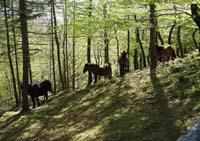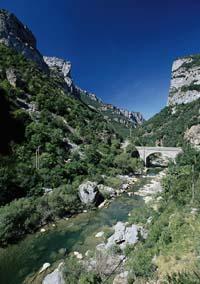In Euskal Herria, the land with pain

The geologist Koldo Nuñez takes us two hundred million years ago. At that time, this territory was part of the supercontinent of Pangea, with impressive deserts. From them come the sandstones, like that of Baztan.
We come to the present. The current Basque Country does not resemble that of then. Located to the west of the European continent, on the eastern shore of the Gulf of Bizkaia, between the rivers Aturri and Ebro. The territory is divided by the Pyrenees and other mountain ranges (Aralar, Aizkorri, Gorbeia), which translates into a heterogeneous climate and landscape.
In the encyclopedic dictionary Harluxet, for example, four climatic regions are distinguished: the Atlantic, the continental Mediterranean, the transition between the Atlantic and the Mediterranean and the mountain. The Atlantic slope and the mountain are rainy and in the zone with transitional climate it rains quite and summers are not dry.
But in the south of the territory, on the banks of the Ebro and Rioja alavesa, summers are warm and dry, and in winter it does not rain much. The average monthly rainfall is usually less than 50 mm, with no large differences
From one month to another. On the contrary, on the Atlantic side average annual rainfall ranges from 1,200-2,000 mm.
Taking into account this classification, therefore, nowhere, the risk of desertification can only exist in the south of Euskal Herria, since in the rest the climate is humid. It must be taken into account that according to the definition of the United Nations, desertification is the degradation of land in arid, semi-arid, and subhumid dry areas.

However, it cannot be said that the soil of Euskal Herria is in good condition, although in general it is not in danger of desertification. On the contrary, the phenomena of degradation are occurring throughout the territory and in recent years are more evident than before.
Constant evolution
In any case, soil erosion is a natural phenomenon and necessary for the formation of soil. The soil grows very slowly by the degradation of the mother rock and is attacked by erosion as it occurs. For this reason, geologists affirm that the terrestrial surface is dynamic, since it is being produced and constantly disappearing.
The breakdown of the balance between both processes involves the loss of soil. Many times this loss is a consequence of human activities, and in Euskal Herria, very long ago, it began to lose the soil.
Biologist Jokin of the Lersundi Valley works in the Department of Agriculture of the Government of Navarre and has been researching the soils of Euskal Herria for years. According to him, in Euskal Herria the soil has been heavily pressured since ancient times. There have been many people in the territory and it has been used all the soil that could be used to earn a living.
His footprints are evident. Therefore, there are some aspects of the Pyrenees that say they are green deserts, because they are green but are very degraded. In fact, from the Neolithic, pastoralists have used the high part of the mountains to grow cattle during the summer. Due to continued use, Aralar, Gorbeia, Bortziriak... many forests have disappeared and pastures dominate.

Likewise, the fires repeated in the creation of pastures have acidified the land. And, in addition to livestock, other activities have contributed significantly to soil degradation, such as deforestation. However, in all the Atlantic slope the erosion is high, due to the steep slope and the abundance of rains.
Therefore, much soil has been lost, there is no more to see where the Roman ports were in the Basque Country: The Urumea was in Hernani, in Deba in Altzola and in Urdaibai in Forua. This reflects the degree of saturation of rivers. Most of the land has reached the rivers by erosion.
At present, soil loss is still important due to the techniques used in the forestry sector. In fact, some techniques of planting pines leave the soil naked and break the structure by mixing layers. In some cases up to 50-80 tons per hectare can be lost in the first few years.
Looking south
The effects of erosion in the south of the territory are even more serious than on the Atlantic side. Human activity has also been constant, both agricultural and forestry and livestock. All this generates a strong pressure on the soil, which also erodes with relative ease. The climate is much drier than on the northern slope and the vegetation takes a lot to recover.

Therefore, it is not surprising that at present the effects of degradation are evident in the lands of the Ribera del Ebro and the Rioja Alavesa. The future is also brown: it is estimated that between 15% and 18% of the land is at risk of desertification.
However, in the last 25 years the erosion has softened, since only arable land with machinery is used. As a result, on sloping grounds in Álava and Navarre, where previously the orchard levels were made and dedicated to agriculture, these terraces are now abandoned.
However, in these abandoned places there may be a risk of the appearance of carcavas, as has happened on occasions. It must be taken into account that when it rains in this area the showers are hard. The drops of water have a great kinetic energy, that is, they give much strength to the soil. The water generates small regattas and these, erosion lines. The stretch marks become deeper and deeper and, over time, channels or channels appear. Finally they become gullies or gullies, small but deep canyons with steep walls.
José Luis Ereso, professor at the University School of Industrial Engineering and Topography of the UPV-EHU, has warned that the recovery of the area with carcavas is very difficult. On the contrary, the phenomenon can advance in certain types of soil. "The heat makes the clayey soils crack. The water that enters through the cracks generates tunnels that if the ceiling is enlarged much falls. In the bardenas there are illustrative examples".
Leadership of the cities
However, Iñaki Antiedad, professor of hydrogeology of the UPV, considers that urbanism, industry and infrastructures are at this time the biggest enemies of the land. Zirikatzaile, believes it is really serious and significant that people come to the head the face of Javier Madrazo, Housing and Social Affairs Advisor, when he talks about soil.

The data are clear: According to the Department of Environment and Land Planning of the Basque Government, in the CAPV between 1994 and 2004 the artificial soil has increased by 20%. In 2000, 39% of the artificial surface was occupied by housing, 18% by economic activities and 43% by means of transport. The same occurs in the Basque Country, especially on the coast, and Navarre is no exception.
The land, however, is much more than housing and infrastructure support and should be more protected. The European Union is working on the soil strategy and experts expect this to be a change. But, in addition, the Antiguo proposes the creation of a “ground observatory” or something like this, to take into account the functions of the soil and act responsibly.
The Antiguo considers that beyond the ground there should be a debate on sustainable development. Yes, what to discuss and analyze.







